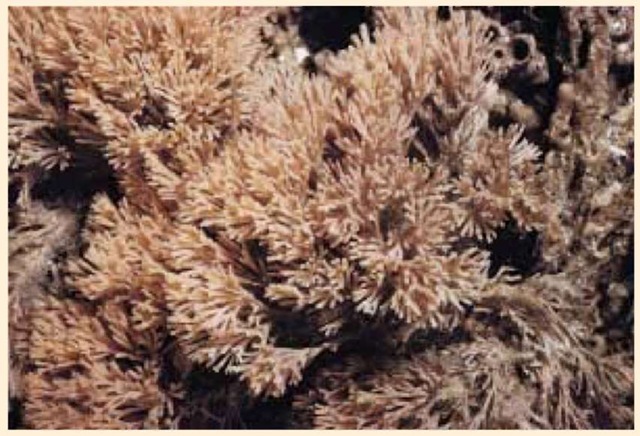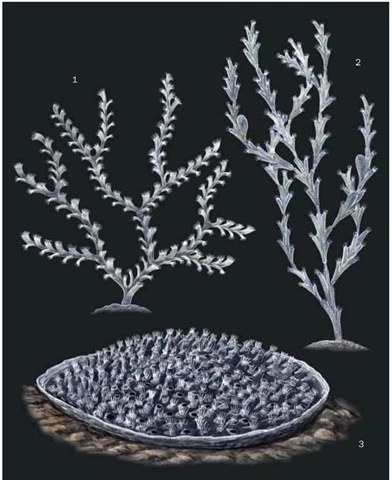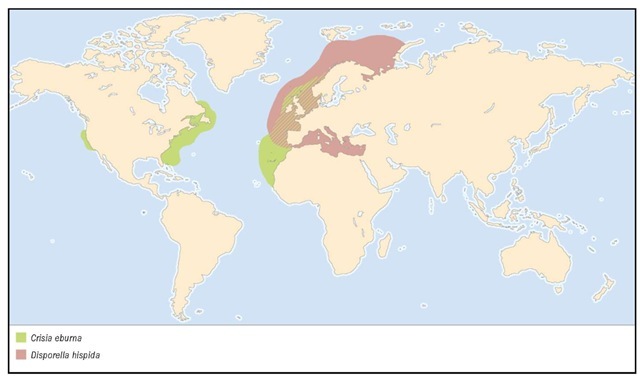Stenolaemata
(Marine bryozoans)
Number of families Approximately 25
Thumbnail description
Colonial marine animals, superficially plantlike in appearance, made up of many units that feed or perform other vital functions, and having rigid, calcified supportive skeletons.
Photo: Crisulipora occidentalis.
Evolution and systematics
Phylum Bryozoa, also called phylum Ectoprocta, sorts itself into three classes: Stenolaemata, Gymnolaemata, and Phy-lactolaemata. Stenolaemata are exclusively marine bryozoans, while Gymnolaemate bryozoans are mostly marine, plus a few freshwater types, and Phylactolaemates bryozoans are entirely reshwater.
The fossil record of class Stenolaemata extends back as far as 400 million years, into the early Ordovician Era. The Steno-laemata have passed their peak of diversification and are now in decline. Stenolaemata comprises one extant order, Cy-clostomata (also called Tubuliporida), which first appeared in the Ordovician and scraped by with small colonies and little diversification through the Paleozoic, then exploded into extraordinary diversity during the Cretaceous. Its diversity declined toward the end of the Cretaceous, the number of genera was whittled down from about 175 to about 50, and the order has maintained that level of diversity into the present. There are about 500 extant species.
Physical characteristics
Stenolaemata, like bryozoans in general, are colonial animals, with many species superficially resembling seaweeds or corals. A common sort of stenolaemate colony consists of a branching array of hollow, calcified tubes, which serves as a skeleton, the tubes studded along the lengths of the tubes with individual, functional units called “zooids.” Stenolaemate colonies can take a variety of forms, including crustlike, rosette, cup-shaped, branching, lumpy, and leaf-shaped. Colonies may bear calcified structures arising from the support skeleton, called “maculae,” that function in colony hygiene, directing “used” water, or water already sifted for food particles and carrying wastes, away from the colony for hygiene purposes.
A single colony may be less than a millimeter high, or grow as high as a few feet (1 m) or more. The individual zooids are microscopic or nearly so. Microscopes are standard and necessary tools for studying and identifying bryozoans.
Stenolaemata zooids are characteristically elongated and cylindrical. Each zooid sits in a chamber called a “zoecium,” encased in a calcified cystid for protection. Zooids within a single colony may differ considerably in form and function (polymorphism). Most numerous are the feeding zooids, or autozooids, each of which has a coelom, or inner body cavity, formed from the mesoderm, as well as a digestive tract, nervous system, and muscles. Although an autozooid feeds independently, it connects and communicates with the entire colony. Non-feeding zooids, or heterozooids, in Stenolaemata include gonozooids (reproductive) and kenozooids, which lack an internal organ system and serve as extra support for the colonial skeleton.
To feed, an autozooid extends an organ called a lophophore, consisting of a tentacle sheath and a ball of rolled-up, hollow tentacles. The tentacles open up into a graceful, flowerlike, bell-shaped structure. Cilia studding the tentacles draw currents of water into the mouth, to the center of the lophophore, and into the digestive tract and gut, with a caecum that grinds up food particles with peristaltic motions. The tract communicates directly, via pores, with another tract running the length of the supporting skeletal tube, allowing ingested food to be shared throughout the colony. A zooid passes its wastes through an anus, on the tentacle sheath below the tentacle ring.
Distribution
Stenolaemate bryozoans, like marine bryozoans in general, are found from the equator well into the arctic and Antarctic
Ocean regions, but their greatest diversity occurs in the cool waters of the temperate latitudes and the cold waters of the near-polar regions.
Habitat
Stenolaemate bryozoans live from shallow, near-shore waters to abyssal depths, but prefer shallow waters. A colony, depending on species, may attach or root itself in its formative stages to nearly any sort of substrate, including rocks, seashells, seaweed, and wooden piers.
Behavior
Stenolaemate bryozoans live passive, stationary lifestyles, similar to corals.
Feeding ecology and diet
Stenolaemata feed themselves via their zooids, which draw water, by the action of their ciliated lophopores, through their bodies, snagging microscopic algae, animals, and organic detritus. A tiny stomach churns up the ingested food with peristaltic contractions, digests it, then absorbs some and passes some on to the rest of the colony.
Reproductive biology
Stenolaemata, like bryozoans in general, reproduce both sexually and asexually. Sexually, most stenolaemata are her- maphroditic. Different species may be simultaneous hermaphrodites, producing sperm and eggs at the same time, or protandric hermaphrodites, producing eggs and sperm at different times. Ovaries and testes form from modified auto-zooids. Most stenolaemata species temporarily keep their fertilized eggs within brood chambers modified from the coela of feeding zooids. Free-swimming sperm are snatched from open water by the autozooids and passed on to the eggs for fertilization.
The fertilized eggs undergo cleavage and become free-swimming larvae that force their way out of the brood chamber and become independent, free-swimming organisms. In a few days, they settle down on a growth-friendly substrate, each larva changing into a rootlike form, the ancestrula, which commences to grow asexually into an entire colony, building the skeleton and budding the zooids; the colony continues to grow in this fashion. If a piece of a colony is broken off from the rest, it can settle and build itself into a new, complete colony.
Conservation status
No species are listed by the IUCN.
Significance to humans
Stenolaemata are of no special significance to humans. In time, they may, since research is being done on bryozoans to find possible biochemicals within them that may have medical benefits.

1. Idmidronea atlantica; 2. Joint-tubed bryozoan (Crisia eburna); 3. Disporella hispida.
Species accounts
Joint-tubed bryozoan
Crisia eburna
ORDER
Cyclostomata
FAMILY
Crisiidae
TAXONOMY
Crisia eburna Linnaeus, 1758.
OTHER COMMON NAMES
None known.
PHYSICAL CHARACTERISTICS
A colony takes the form of an upright, white miniature shrub or tuft, with many calcified branches. Colonies grow from 0.31-0.98 in (8-25 mm) high. Zooecia are arranged in two alternate rows on each branch.
DISTRIBUTION
Temperate to subtropical marine. Common in Woods Hole in Massachusetts, San Francisco Bay, and offshore Florida, United States.
HABITAT
Marine, living offshore and in brackish estuaries.
BEHAVIOR
Like most bryozoa, it is a stationary, colonial organism; colony feeds by means of autozooids.
FEEDING ECOLOGY AND DIET
Feeds on algae and other marine microorganisms by means of autozooids.
REPRODUCTIVE BIOLOGY
Observations lean toward it being hermaphroditic and protan-drous. Breeding in San Francisco Bay runs from late February-May. Mature fertilized eggs are found in partially formed zooid buds that metamorphose into gonozoids, or brooding zooids, each nurturing a single embryo. Gonozooid is shaped like a vase, with a fat mid-region and a short neck, and is attached to the main colonial skeleton by a narrow stalk. The neck provides an opening for the escape of free-swimming larvae.
The eggs are fertilized internally, but the details of maturation and fertilization are not known. Fertilization is internal. The egg undergoes cleavage and develops into a 200-cell sphere, and then it goes on to undertake a process found only in stenolaemate bryozoans, producing buds that become independent, secondary embryos. These develop into free-swimming larvae and leave the gonozooid through its open neck. These settle, become ancestrules, and produce new colonies.
CONSERVATION STATUS
Not listed by the IUCN.
SIGNIFICANCE TO HUMANS
No common name
Disporella hispida
ORDER
Cyclostomata
FAMILY
Lichenoporidae
TAXONOMY
Disporella hispida Fleming, 1828.
OTHER COMMON NAMES
None known.
PHYSICAL CHARACTERISTICS
Known for wide variation in form among its colonies, which may be round or oval, flat, concave or cup-shaped, convex or mound-shaped; or colonies may form as sheets with several centers of growth. Colonies often form daughter colonies at their peripheries, while separate colonies may grow into and merge with one another. The calcified skeletons have complex forms. Autozooids in the colonies are arranged in rows radiating from the circular center.
DISTRIBUTION
Throughout the North Atlantic from Barents Sea to the eastern Mediterranean on the European side, and from Arctic Canada to Florida on the North American side.
HABITAT
Lives in offshore marine waters, to the edge of the continental shelf, at home on a wide array of substrates, including algae, rocks, shells, crustacean exoskeletons, and even other bry-ozoans.
BEHAVIOR
Stationary and passive, feeding on marine microorganisms.
FEEDING ECOLOGY AND DIET
Feeds on marine microorganisms by means of its autozooids.
REPRODUCTIVE BIOLOGY
Follows the general pattern for stenolaemate bryozoa.
CONSERVATION STATUS
Not listed by the IUCN.
SIGNIFICANCE TO HUMANS
None known.
No common name
Idmidronea atlantica
ORDER
Cyclostomata
FAMILY
Tubuliporidae
TAXONOMY
Idmidronea atlantica Johnston, 1847.
OTHER COMMON NAMES
None known.
PHYSICAL CHARACTERISTICS
Colonies are erect with dichotomous, symmetrical branching, forming fanlike structures, but shapes and structures of

individual colonies vary according to the immediate environment, also showing palmlike and elongated, irregularly branched forms. Zooids are placed alternately along axes of skeletal tubes.
DISTRIBUTION
Found from northern European Atlantic Ocean south to and throughout the Mediterranean; also in the Gulf of Mexico. Its full range is still unknown.
HABITAT
Marine species, living offshore on rocky and broken-shell gravel substrates.
BEHAVIOR
Sedentary, feeding on marine microorganisms by means of autozooids.
FEEDING ECOLOGY AND DIET
Feeds on marine microorganisms by means of autozooids.
REPRODUCTIVE BIOLOGY
Follows the general stenlaemate pattern, as exemplified in Crisia eburna.
CONSERVATION STATUS
Not listed by the IUCN.
SIGNIFICANCE TO HUMANS
None known.

